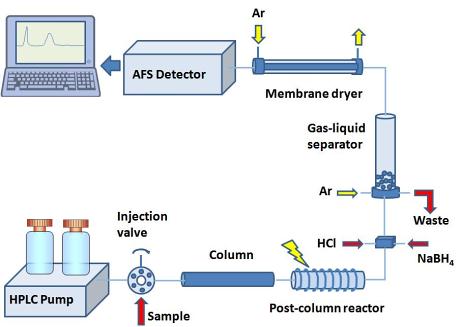Atomic Fluorescence Spectrometry (AFS) represents a suitable alternative to the other atomic and mass spectrometric techniques. Since atomic fluorescence can be quenched by many molecules, an effective separation of the analyted from the matrix and/or a very efficient atomization is required. By using the argon-hydrogen diffusion flame (only a moderately hot atomizer) the AFS technique is an ideal detection technique for speciation studies concerning hydride forming elements (mainly As, Se and Sb) and Hg.
AFS has been described to be superior to AAS, especially with respect to its greater sensitivity based on the fact that the fluorescence signal has a very low background.
Compared to ICP-MS, AFS has very similar sensitivity and linear range, but is a relatively simple set-up and has lower investment and maintenance costs. In addition, adaptation of the chemical vapor generation (CVG) system to the AFS detector is easy and yields good results. Unlike ICP-MS, the AFS detector is more tolerant of external hydrogen formed during the CVG process. Hence, it is compatible with the on-line vapor-generation system, which makes it most suitable for measuring vapor-forming species.
 Figure: General principle of an HPLC-CVG-AFS system
Figure: General principle of an HPLC-CVG-AFS system
AFS spectrometers are commonly based on the use of non-dispersive instruments, equipped with Boosted Discharge Hollow Cathode Lamps (BDHCLs) or a mercury vapor discharge lamp as the excitation radiation source. Historically, other more powerfull atomizers such as the Inductively coupled plasma have also been investigated , however no commercial instrument is nowadays available.
The volatile species of As, Se and Sb, obtained from liquid samples after hydride generation, are carried with an argon flow to a gas–liquid separator, followed by atomization and excitation in an argon–hydrogen diffusion flame. For mercury, the cold vapor technique is employed, with no need of a flame for atomization. For those chemical species that do not readily form volatile species, such as some complex organometallic species, additional online derivatisation steps are needed before hydride- or cold vapor generation.
HPLC-CVG-AFS is one of the most popular techniques used for speciation studies of chemical-vapor-forming elements. Unfortunately, the development of the techniques has not been as fast as one would like and also is supported by only very few instrument manufacturers. The key reason for this situation is the post-column treatment generally required by the nature of the technique in order to assure that all species eluting from the column are transformed to volatile species with the same efficiency. Such additional derivatization in general is performed on-line with post-column reactors aiming at the destruction of the species to only free elemental cations accessible for vapor generation. On-line oxidation with strong oxidants, photo-oxidation, or microwave digestion has been used for such purpose.
 Related Reviews of the technique
Related Reviews of the technique

Yasin Arslan, Emrah Yildirim, Mehrdad Gholami, Sezgin Bakirdere,
Lower limits of detection in speciation analysis by coupling high-performance liquid chromatography and chemical vapor generation, Trends in Analytical Chemistry, 30/4 (2011)569-585.
doi: 10.1016/j.trac.2010.11.017

D. Sanchez-Rodas, W.T. Corns, B. Chen, P.B. Stockwell,
Atomic Fluorescence Spectrometry: a suitable detection technique in speciation studies for arsenic, selenium, antimony and mercury, J. Anal. At. Spectrom., 25 (2010) 933–946.
doi: 10.1039/b917755h

Yu-Wei Chena, Nelson Belzile,
High performance liquid chromatography coupled to atomic fluorescence spectrometry for the speciation of the hydride and chemical vapour-forming elements As, Se, Sb and Hg: A critical review, Analytica Chimica Acta 671 (2010) 9–26.
doi:10.1016/j.aca.2010.05.011

Hideyoshi Morita, Hideji Tanaka, Shigeru Shimomura,
Atomic fluorescence spectrometry of mercury: principles and developments, Spectrochimica Acta, Vol. 50B/1 (1995) 6944.
doi: 10.1016/0584-8547(94)00116-D
 Related EVISA Resources
Related EVISA Resources
 Company Database: Manufacturers of AFS Instruments
Company Database: Manufacturers of AFS Instruments
 Instrument Database: Atomic Fluorescence Systems
Instrument Database: Atomic Fluorescence Systems
 Company Database: Organizations related to Atomic Spectroscopy
Company Database: Organizations related to Atomic Spectroscopy
 Journal Database: Journals related to Atomic Spectrometry
Journal Database: Journals related to Atomic Spectrometry
 Link Database: Analytical methods based on AFS
Link Database: Analytical methods based on AFS
 Link page: All about Atomic Spectrometry
Link page: All about Atomic Spectrometry
 Further chapters on techniques and methodology for speciation analysis:
Further chapters on techniques and methodology for speciation analysis:
 Chapter 1:
Tools for elemental speciation
Chapter 1:
Tools for elemental speciation Chapter 2: ICP-MS - A versatile detection system for speciation analysis
Chapter 2: ICP-MS - A versatile detection system for speciation analysis Chapter 3: LC-ICP-MS - The most often used hyphenated system for speciation analysis
Chapter 3: LC-ICP-MS - The most often used hyphenated system for speciation analysis Chapter 4: GC-ICP-MS- A very sensitive hyphenated system for speciation analysis
Chapter 4: GC-ICP-MS- A very sensitive hyphenated system for speciation analysis Chapter 5: CE-ICP-MS for speciation analysis
Chapter 5: CE-ICP-MS for speciation analysis Chapter 6: ESI-MS: The tool for the identification of species
Chapter 6: ESI-MS: The tool for the identification of species Chapter 7: Speciation Analysis - Striving for Quality
Chapter 7: Speciation Analysis - Striving for Quality  Chapter 8: Atomic Fluorescence Spectrometry as a Detection System for Speciation Analysis
Chapter 8: Atomic Fluorescence Spectrometry as a Detection System for Speciation Analysis  Chapter 9: Gas chromatography for the separation of elemental species
Chapter 9: Gas chromatography for the separation of elemental species  Chapter 10: Plasma source detection techniques for gas chromatography
Chapter 10: Plasma source detection techniques for gas chromatography Chapter 11: Fractionation as a first step towards speciation analysis
Chapter 11: Fractionation as a first step towards speciation analysis  Chapter 12: Flow-injection inductively coupled plasma mass spectrometry for speciation analysis
Chapter 12: Flow-injection inductively coupled plasma mass spectrometry for speciation analysis  Chapter
13: Gel electrophoresis combined with laser ablation inductively
coupled plasma mass spectrometry for speciation analysis
Chapter
13: Gel electrophoresis combined with laser ablation inductively
coupled plasma mass spectrometry for speciation analysis  Chapter 14: Non-chromatographic separation techniques for speciation analysis
Chapter 14: Non-chromatographic separation techniques for speciation analysis
last time modified: January 14, 2024